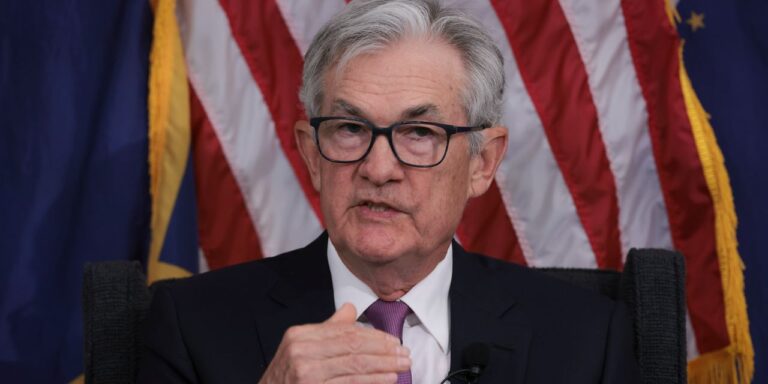
[ad_1]
Text size

Federal Reserve Chairman Jerome Powell.
Win McNamee/Getty Images
The stock market has recently been pretty calm, edging higher despite the usual drag from high interest rates. What people who say the current rally can’t last are missing is that this is a signal that rates could fall soon.
The S&P 500 is up about 20% from its bear-market low in early October. Much of the recent gain has come from Big Tech stocks, which are benefiting from the advent of artificial intelligence.
But even before that, markets were hoping that the Federal Reserve will soon pause in raising interest rates as inflation and economic growth have slowed down. An end to rate increases, even if temporary, would help economic growth to stabilize, with positive results for corporate profits and stock prices.
As investors look ahead to smoother waters for the market, the Cboe Volatility Index (VIX), a measure of expected stock-price volatility known as Wall Street’s fear gauge, has fallen from an October peak of about 32 to around 13. It is now near its lowest level since just before the March 2020 lockdowns.
The bond market reflects a less optimistic view. The MOVE Index, which measures bond-market volatility, is at 115, down a touch in the past few months, but well above its record low of 36 hit in late 2020. It hasn’t fallen in lockstep with the reduction in stock market volatility, reflecting concern that the 10 interest-rate increases the Fed has rolled out starting in March 2022 will wreak more havoc on the economy.
Tighter monetary policy usually takes effect on the economy with a delay. And with the Fed’s target for the fed-funds rate at 5%-5.5%, borrowing costs are high.
That’s why many are now doubting the stock market. The
S&P 500
is now trading at an expensive level, putting it at risk, especially since safe Treasury debt is yielding way more than it used to, causing some to wonder how anyone can keep buying stocks at these levels. And certainly, the stock market could experience a correction if a recession proves more difficult than anticipated for companies’ earnings, a dynamic that could drive money into bonds.
“It’s now time for a bit of a tree shaking to wring out some of the complacency that everything will be just fine notwithstanding tight money, quantitative tightening and the various economic challenges that will not change for a while,” wrote Peter Boockvar, chief investment officer at Bleakley Advisory Group.
But there’s rhyme to the stock market’s reason.
One of the best explanations for the stock market’s calm is that investors are anticipating lower rates. There is some chance that the Fed will cut rates later this year, given that inflation has been cut almost in half in about a year’s time. Easier monetary policy could help the Fed steer the economy to a soft landing.
Even if there are no cuts soon, a pause in rate increases could bring the 2-year Treasury yield down a bit, making stocks more appealing.
It isn’t the first time the stock market has calmed down while the bond market has acted out. There were several stretches of months between the 2008-2009 financial crisis and the pandemic, when the stock market became calm and the bond market remained volatile, according to RBC.
“It’s not unusual for the VIX to fall before MOVE,” wrote Lori Calvasina, chief U.S. equity strategist at the firm.
When a stock market rally feels hard to believe, take a closer look at the reasons. There may be a message there.
Write to Jacob Sonenshine at [email protected]
[ad_2]